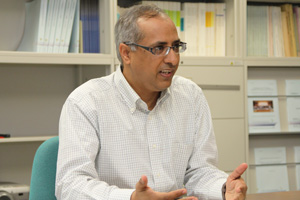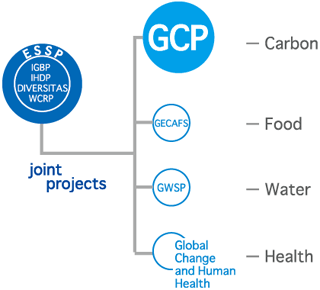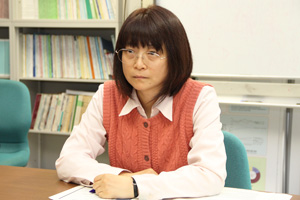2011年12月号 [Vol.22 No.9] 通巻第253号 201112_253003_en
Interview in the front line of climate change Integrated research creates new knowledge
- Dr. DHAKAL Shobhakar
Executive Director, Global Carbon Project Tsukuba International Office, National Institute for Environmental Studies - Specialty field: Energy and carbon systems analyses with the main focus on cities
- Interviewer: Dr. SAIGUSA Nobuko, Head of the Office for Terrestrial Monitoring, Center for Global Environmental Research
Recently, climate change has become a serious concern, and a movement from mere scientific clarification to concrete countermeasures and international negotiations has been witnessed. Nevertheless, are the implications of global warming really understood? Are the paths towards a Low-Carbon Society in Japan and around the world made sufficiently clear? What are the next steps to be taken according to climate change researchers and what do they mean to us? In this column we are trying to find the answers to “Climate Change Research Today and Tomorrow” by interviewing researchers in the front line of the climate change field about their research projects and their background.
Dr. DHAKAL Shobhakar
- 1970 Born in Nepal
- 2000 Ph.D. in Urban Engineering, The University of Tokyo
- 2000–2006 Climate Policy Project and Urban Environmental Management Project, Institute for Global Environmental Strategies (IGES)
- 2006–present Executive Director, GCP Tsukuba International Office, National Institute for Environmental Studies (NIES)
I like reading non-fiction books on history, religion and philosophy. I also enjoy traveling and swimming, not to mention amateur photography which is really one of my favorite pastimes.
Saigusa: Thank you very much for your time. Today I would like to ask your personal opinion about the Global Carbon Project (GCP), your career, your work as the Executive Director and your vision for the future. First, could you please explain to the readers of this newsletter what GCP is, what its main objectives are and what you are doing as its director?

Dhakal: Yes, thank you. The Global Carbon Project is an international scientific program affiliated with the Earth System Science Partnership (ESSP), which, at the higher level, operates under the framework of the International Council of Science and the International Social Science Council. We focus on the carbon cycle and management. (For details, please visit the following website: http://www.cger.nies.go.jp/gcp/)
Our mandate is to facilitate carbon cycle and management research and to coordinate the scientific community with the main focus on integration of disciplines. Since carbon cycle and management is a broad topic, it requires colleagues from the biogeochemical, biophysical and social science disciplines to work together. Our role is to bring them and their expertise together as an international coordination platform, frame an integrative science and facilitate the production high level knowledge. We also assist in scientific capacity building in regions where there is not enough capacity. So in a sense, GCP’s domain is wide, but in principle it focuses on coordination, scientific excellence, capacity building and science communication for decision-making. I think these are our mandates.

Saigusa: I see, GCP covers not only natural science, but also social science and policy. Can you explain the difference between individual project-based research and GCP’s synthetic or integrative science and research?
Dhakal: I think you raised a very important point. Most of the core research is done along the disciplinary lines because it needs deep knowledge and many years of work, so individual researchers do very detailed research. But when we want to create science which has more societal relevance, we have to communicate with other research communities and colleagues of other disciplines, and integrate different knowledge together. In integrative research we create new knowledge, some kind of synthetic knowledge which utilizes the expertise of individual scientists in individual areas and disciplines, but generate new knowledge that is not fragmented science fields.
Saigusa: As you pointed out, GCP covers a very wide area. Are there any branches in GCP, and what is the main focus of GCP at NIES?
Dhakal: GCP has two international project offices, this office at NIES and an office at CSIRO in Canberra, Australia. These two offices coordinate the day-to-day operation. We also have local offices in Beijing and Seoul. GCP is very much a network based scientific program so we have a close communication with key national and regional carbon related scientific programs worldwide, and we facilitate for colleagues worldwide to get together on particular issues. The Tsukuba Office focuses more on the human dimension and social science. From the Tsukuba Office we have launched a few important activities. One of them is the Urban and Regional Carbon Management Initiative.
Saigusa: Could you explain more specifically what the most important activity or product was during the past one or two years in your office?
Dhakal: We were involved in several projects, but the two most important involvements were the Urban and Regional Carbon Management (URCM http://www.gcp-urcm.org) and Global Carbon Budget. We were involved in generating and communicating synthetic knowledge. These include scientific networking, science communication, and synthesis. And most importantly, we have been closely involved with IPCC and other major international assessments such as the Global Energy Assessment and Regional Carbon Assessment (RECCAP http://www.globalcarbonproject.org/reccap/). RECCAP in particular is GCP initiated and we also played an important role in facilitating the urban chapter of the Global Energy Assessment (http://www.globalenergyassessment.org).

Saigusa: Many scientists are originally educated in a specific area. You have also a PhD in one specific area but you have changed jobs a couple of times and had several important positions, and now you are an executive director of GCP and you are doing synthesis work. Could you tell me about your career, how you arrived at this kind of synthesis work?
Dhakal: Yes. Actually this kind of integrated research was my interest from the beginning, but fortunately, I have also the opportunity to carry out my own research together with the GCP duties. Before I joined GCP, GCP was trying to develop the urban carbon area. Basically I came from that particular field, so it was interesting and contextual for me. I do two things together as the executive director: on the one hand I facilitate work on a broader carbon agenda, and at the same time I carry out research as urban energy and carbon expert in GCP’s urban carbon agenda.
If you look at the different international scientific programs, the extent to which executive officers/directors are involved in actual research varies greatly. In my personal opinion, one of the reasons why GCP is successful is partly because its executive directors carry out some component of research together with their main tasks of coordination of the broader agenda.
Saigusa: Research related to GCP is conducted at many institutes, at least in Japan. What do you think is the advantage of having your office at NIES?
Dhakal: It makes a great value for GCP to be at an institute like NIES, because NIES has such an excellent expertise in different areas of carbon cycle and management. We can get a lot of intellectual support from NIES. At the same time, we have a huge opportunity to bring the expertise of the international research community that will help NIES colleagues to step into the international integrative science arena. Then, of course, being at NIES, we collaborate and communicate with a lot of colleagues, so many new ideas are generated and new opportunities are created. We try to create a bridge between the Japanese community or NIES colleagues and the international community as much as possible. So I think it is a perfect match.
Saigusa: Yes, I also think that there is a huge potential and benefit for both the GCP program and NIES, but I feel there is sometimes a kind of a communication shortage. I think if we had more communication or more joint work, we may be able to go to the next stage. What is the key to joint work?
Dhakal: Let me explain how the activities are formed in GCP. GCP is quite an open organization in terms of colleagues collaborating with us. My own personal feeling is that when we want to get involved with good scientists, we need two things. We have to have either a lot of resources at our hand, funding or money, or a very interesting research agenda and ideas so that individual scientists and institutions are willing to work jointly with us. In GCP we do not always have resources at hand when we start something. We generate interesting ideas through interactions and we form small groups of colleagues around interesting ideas to explore. If that matures, we start some activity and look for funding to implement it. So what is important, as you correctly said, is an active communication and participation in each other’s activities. Another key aspect is also scientist’s willingness to go a step beyond their own core-area-of-expertise and be open to explore new areas.
As you know, the GCP research portfolio is broad. That doesn’t mean we can cover everything. The GCP research agenda, we call it Science Plan, is very important, but we don’t have to, or do not necessarily implement everything. Based on the interest of the community some things go very well, it really builds-up, we publish papers and produce good products. But sometimes we start something, but there is not a significant interest and we can’t realize it, so we move to other activities. The most important part I think is communication, interaction, and willingness of colleagues to work together for a common cause.
Saigusa: I see. Could you point out one or two good examples, successful initiatives you made during the past one or two years?
Dhakal: Well, in the area of Urban Carbon Management, we had a very good collaboration with NIES colleagues, especially with Yamagata-san and Ichinose-san, and an active communication with Kainuma-san, Moriguchi-san and others. Also, Prof. Keisuke Hanaki from the University of Tokyo serves as a member of our scientific steering committee and we had organized joint events with the Integrated Research System for Sustainability Science (IR3S). We have also a close collaboration with Hiroshima University and Nagoya University. Also in topics like RECCAP, we have a very active involvement of Ito-san. Whenever we have an opportunity, we try to have more Japanese colleagues to be involved in these programs. International scientific programs are open, very interactive, and try to create more synthesized ideas, but as you know, the Japanese colleagues are sometimes shy in discussions. I think we have to have more Japanese colleagues going to such meetings so that we can have a better Japanese representation and contributions. We try to do such bridging; whenever there is a call for a member of the scientific steering committee and different scientific programs, we pass the relevant information on to our NIES colleagues, and inform about their expertise to the international community too.
Saigusa: You gave us two good examples, the Urban Carbon Initiative and RECCAP. Could you explain a little bit more specifically about these two initiatives? How many years have you worked with them and what are the most successful products, such as papers or reports?
Dhakal: We have been running the Urban Carbon Initiative for 5 years now and we have done three special issues in reputed international journals. We have developed the Urban Energy and Carbon Modeling Forum, where researchers in the area come and make a presentation and discuss about modeling and analysis. We hosted a series of joint events with Nagoya University, the Asian Institute of Technology (AIT), the International Institute for Applied System Analyses (IIASA), Potsdam Institute, ECN Netherlands, International Human Dimension Program (IHDP) and others. We had also a very good collaboration with IR3S of Todai for different events as well as we supported various international assessments.
In terms of publications, over 40 publications in journals were either directly done by us or facilitated by our program. In the case of the Global Carbon Budget Initiative, we make annual press releases (http://www.nies.go.jp/whatsnew/2011/20111205/20111205-e.html) through NIES and get coverage in most of the Japanese media. But I think, there is still room for improvement so I am trying to promote more collaboration between NIES and GCP.
In the context of RECCAP, we realized that South Asia and South East Asia have a huge gap in knowledge and information on carbon cycle and management. So we think that this could be our niche area where NIES could play an important role. We have colleagues at NIES who have expertise in different areas that are needed for regional assessment, and at the same time, we have a strong link with Asia at NIES. I am hoping that, in some areas, NIES colleagues could take a leadership role. There is a huge potential for us to work together.
Saigusa: I agree with you that there is a huge observational and knowledge gap in South East Asia and South Asia. What can we do to fill this knowledge gap in these regions?
Dhakal: Well, I think we need to do more research on South Asia and South East Asia and also build a network of scientists and build local capacity through joint collaboration in that region. Just last week, actually, GCP and collaborators such as the Asia-Pacific Network for Global Change Research (APN) and the Japan Agency for Marine-Earth Science and Technology (JAMSTEC) organized a workshop in India as one of our efforts to try to reach out to South Asia and South East Asia. I think we have to first sketch what kind of information is needed for synthetic knowledge in these regions. We have some ideas from RECCAP and I think that learning from RECCAP we can assess what the specific gaps are, in which areas we have to build an information base and how we can build a research network in different regions. It needs a bit of a planning and thinking perhaps, but it’s clearly a niche for the community.

Saigusa: There are many scientific and political issues or problems, and there is an urgent necessity, demand to build up a kind of international consensus or guideline in some areas. Do you have a vision about what you want to do in the near future?
Dhakal: There are some activities that I think are very important for GCP to develop in the next 10 years. Actually we had a special issue in “Current Opinion on Environmental Sustainability Journal”, where we pointed out the key directions for the future in the carbon cycle science research. Those directions are our guidelines to take GCP into the next stage. There are a number of different interesting topics which GCP is interested in, like the analyses and knowledge regarding REDD+ issues, other land-based carbon management issues, negative emissions, carbon’s linkage with other components of the earth system, global carbon observation systems etc. Our challenge now is to really start with these activities. For that, NIES colleagues are the perfect partners. If we can develop one or two activities in that line together with NIES colleagues or the Japanese scientific community it would be very fruitful.
Saigusa: Thank you very much. I feel that I’d like to be a kind of bridge between your community and our community and I really hope to have a good cooperation with you. Finally, do you have any message to the readers of this newsletter? This newsletter is widely distributed to not only established scientists but also to young scientists and students, and also to citizens who are interested in environmental problems. So the audience is quite broad. As the director of GCP, do you have any message to the audience?
Dhakal: Yes, I’d like to welcome all colleagues to collaborate with GCP. GCP is a very open and collaboratory program. We don’t have much funding or money, but we have an interesting research agenda and scientific network. I think our strength lies in our ability to coordinate colleagues, to generate an interesting research agenda, and to facilitate that process. GCP would also like to carry out more application-oriented activities. By that I mean that we contribute with science to help policy makers and the society directly. The activities that GCP typically does are usually very integrative, so we need colleagues who are brave enough to go beyond what they do, go one step beyond their core expertise area, and then try to integrate it to a bigger picture. Any opportunity for collaboration, anything we can do together, any suggestions will be greatly appreciated.
Saigusa: Thank you.



